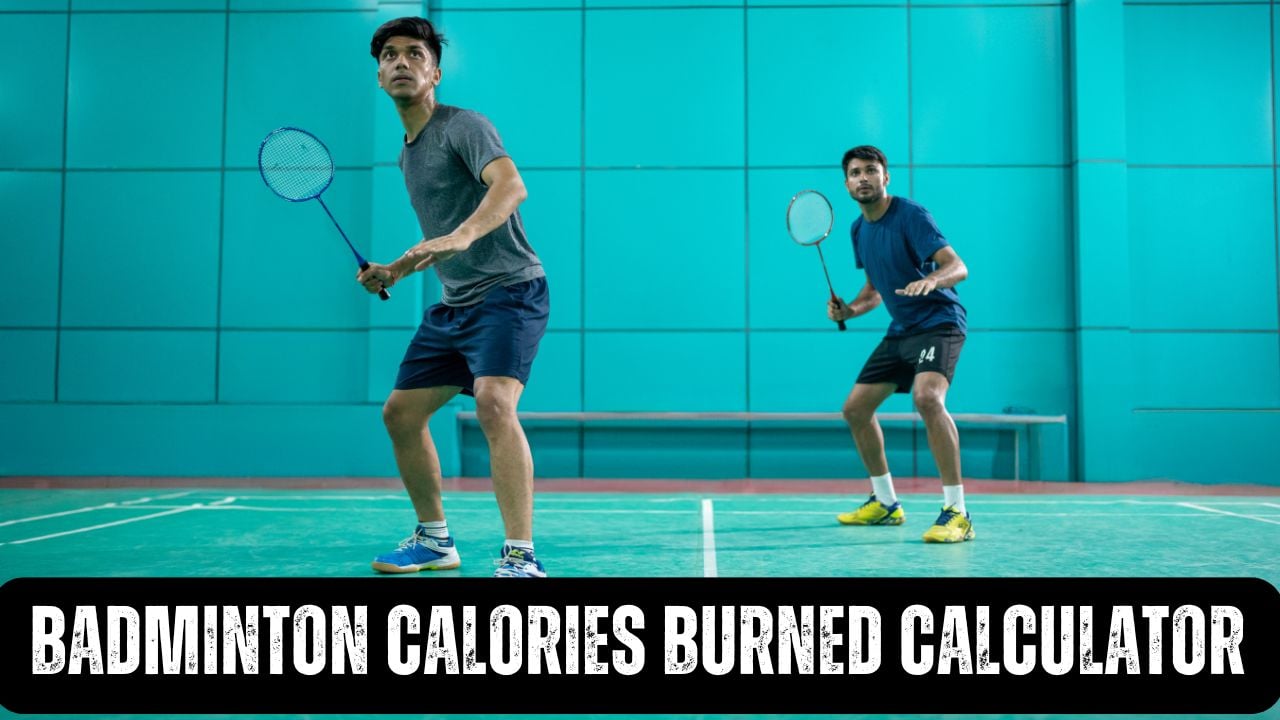Badminton Calories Burned Calculator
Advanced racket sport energy expenditure calculator with scientific MET analysis and competitive play performance tracking

How Many Calories Does Badminton Burn?
Badminton burns between 385-630 calories per hour, depending on play intensity, skill level, and court movement patterns. A typical 60-minute session burns approximately 300-500 calories for most players. As one of the fastest racket sports, badminton provides excellent cardiovascular benefits through rapid directional changes, quick reflexes, and explosive movements.
The sport’s unique combination of overhead shots, lunges, and court coverage creates high energy demands while improving agility and coordination. Professional matches can reach peak intensities of 9.0 METs, making badminton comparable to vigorous cycling or running.
For comprehensive racket sport comparisons, explore our tennis calorie calculator to see how badminton compares to other court sports.
Science of Badminton Calorie Burn
Badminton calorie burn depends on multiple sport-specific factors including shuttlecock speed (up to 400+ km/h), court coverage patterns, rally duration, and shot technique. Research published in the Journal of Sports Medicine demonstrates that badminton provides intermittent high-intensity exercise with significant energy expenditure through explosive movements and rapid directional changes.
Our calculator incorporates these validated research findings to provide accurate calorie estimates for all badminton intensities. For additional racket sport training, explore our MET calculator to understand metabolic equivalents across different activities and leg strengthening exercises for improved court movement.
⚡ MET Values and Badminton Intensity
Our calculator uses scientifically validated MET (Metabolic Equivalent of Task) values derived from the Compendium of Physical Activities.
MET values for badminton range from 5.5 for social play to 9.0 for competitive match play. These values are based on oxygen consumption measurements during actual badminton sessions and provide accurate estimates for calorie expenditure across different play styles, including recreational doubles, competitive singles, tournament matches, and training sessions.
🎯 Factors Affecting Badminton Calorie Burn
Multiple factors influence badminton energy expenditure: play intensity (social vs competitive vs tournament), court movement (coverage patterns and speed), skill level (technique efficiency affects energy cost), rally duration (longer rallies increase demands), shot selection (overhead vs underhand shots), and match format (singles vs doubles play).
Badminton Calorie Formula & Methodology
📊 Scientific Calculation Method
Primary Formula: Calories = (Time × MET × 3.5 × Weight) / 200
MET Determination: MET = Base Play Style MET × Skill Factor × Movement Factor
Badminton Play Style MET Values (Compendium of Physical Activities):
• Social/Recreational Play: 5.5 METs (Code 15030)
• Competitive Play: 7.0 METs (Code 15020)
• Tournament/Match Play: 9.0 METs (Code 15025)
• Training/Coaching: 6.5 METs (Estimated)
• Doubles Play: 5.0 METs (Estimated)
• Singles Play: 7.5 METs (Estimated)
Adjustment Multipliers:
Skill Level: Beginner 1.15x | Intermediate 1.0x | Advanced 0.95x | Professional 0.9x
Movement: Low 0.85x | Moderate 1.0x | High 1.15x | Intense 1.3x
Badminton Intensity Standards & Performance
| Play Style | MET Value | Intensity Level | Calories/Hour (70kg) | Characteristics |
|---|---|---|---|---|
| Doubles Play | 5.0 | Light-Moderate | 350 cal/hr | Shared court, strategic positioning |
| Social/Recreational | 5.5 | Moderate | 385 cal/hr | Casual play, mixed skill levels |
| Training Sessions | 6.5 | Moderate | 455 cal/hr | Skill development, drills |
| Competitive Play | 7.0 | Vigorous | 490 cal/hr | Structured matches, consistent effort |
| Singles Play | 7.5 | Vigorous | 525 cal/hr | Full court coverage, high intensity |
| Tournament/Match | 9.0 | Very Vigorous | 630 cal/hr | Competitive matches, maximum effort |
Note: MET values are based on Compendium of Physical Activities research. Actual calorie burn varies with court movement, rally intensity, skill level, and individual playing style. High-movement play can increase values by 15-30%.
How Many Calories Does Badminton Burn Over Time?
⏱️ Time-Based Calorie Burn Estimates
The duration of badminton play directly impacts total calorie expenditure. These estimates are based on competitive play (7.0 METs) with moderate court movement, providing reliable estimates for fitness planning and tournament preparation. For comprehensive fitness tracking, explore our BMR calculator to understand your daily caloric needs and combine with core strengthening exercises for improved court stability.
| Time | 130 lb (59 kg) | 150 lb (68 kg) | 175 lb (79 kg) | 200 lb (91 kg) | 225 lb (102 kg) | 250 lb (113 kg) |
|---|---|---|---|---|---|---|
| 15 mins | 61 cal | 71 cal | 83 cal | 95 cal | 106 cal | 118 cal |
| 30 mins | 123 cal | 143 cal | 166 cal | 190 cal | 213 cal | 237 cal |
| 45 mins | 184 cal | 214 cal | 249 cal | 285 cal | 320 cal | 355 cal |
| 60 mins | 245 cal | 285 cal | 332 cal | 380 cal | 427 cal | 474 cal |
| 90 mins | 368 cal | 428 cal | 498 cal | 570 cal | 640 cal | 711 cal |
| 2 hours | 490 cal | 570 cal | 664 cal | 759 cal | 854 cal | 948 cal |
Note: Values based on competitive badminton (7.0 METs) with moderate court movement. Tournament play and high-intensity singles can increase values by 25-40%. Social doubles may reduce values by 10-20%.
Badminton vs Other Racket Sports: Calorie Comparison
🏸 Racket Sport Energy Expenditure Comparison
Badminton offers unique metabolic advantages compared to other racket sports through its distinctive movement patterns and game dynamics. While tennis emphasizes powerful groundstrokes and lateral movement, badminton focuses on explosive vertical movements, rapid direction changes, and precise overhead techniques. The shuttlecock’s flight characteristics create varied rally intensities that challenge different energy systems.
| Racket Sport | MET Value | Play Style | Calories/Hour (70kg) | Key Movement Patterns |
|---|---|---|---|---|
| Badminton – Social | 5.5 | Recreational | 385 cal | Multi-directional, overhead focus |
| Tennis – Recreational | 5.0 | Casual play | 350 cal | Lateral movement, groundstrokes |
| Badminton – Competitive | 7.0 | Structured matches | 490 cal | Explosive jumps, quick reflexes |
| Tennis – Competitive | 6.0 | Singles match | 420 cal | Power shots, court coverage |
| Badminton – Tournament | 9.0 | Elite competition | 630 cal | Maximum intensity, precise technique |
| Squash – Competitive | 12.0 | Fast-paced | 840 cal | Continuous movement, wall dynamics |
Note: Badminton provides excellent calorie burn with lower joint impact compared to tennis. Compare with our tennis calorie calculator and squash calorie calculator for comprehensive racket sport fitness planning.
FAQs
❓ How accurate is the badminton calorie calculator?
Our calculator uses the scientifically validated formula: Calories = (Time × MET × 3.5 × Weight) ÷ 200, combined with research-based MET values from the Compendium of Physical Activities. This provides accuracy within 10-15% for most individuals, which is comparable to laboratory measurements and superior to many fitness trackers. The calculations incorporate badminton-specific factors like play style, skill level, and court movement patterns.
🏸 Why does play style significantly affect calorie burn?
Different badminton play styles create vastly different energy demands. Tournament matches (9.0 METs) require maximum effort with explosive movements and sustained high intensity, while social doubles (5.0 METs) involves more relaxed play with shared court coverage. Singles play demands full court coverage, increasing energy expenditure by 20-40% compared to doubles play due to individual responsibility for all court areas.
💪 Which muscles does badminton primarily target?
Biomechanical research shows badminton engages multiple major muscle groups: shoulders and arms (overhead shots), core muscles (rotation and stability), quadriceps and glutes (lunging and jumping), calves (quick movements), and back muscles (posture during play). This comprehensive muscle activation makes badminton excellent for total body conditioning and calorie expenditure.
⚡ How does badminton compare to other cardio exercises?
Badminton offers unique advantages: 1) Sport-specific skills development alongside fitness, 2) Social interaction and competitive motivation, 3) Variable intensity that challenges different energy systems, 4) Improved coordination and agility, and 5) Lower joint impact than running. Tournament-level badminton can burn 600+ calories per hour while providing skill development and competitive enjoyment that pure cardio exercises may lack.
🏃♂️ Why does court movement affect energy expenditure?
Court movement patterns directly impact calorie burn through distance covered, movement speed, and direction changes. High-movement play involving full court coverage can increase energy expenditure by 15-30% compared to static play. Explosive lunges, rapid direction changes, and continuous court coverage activate different muscle groups and energy systems, significantly increasing overall metabolic demand throughout the match or training session.
🏸 Sports Performance & Health Disclaimer
This badminton calorie calculator provides estimates based on scientific formulas and should not replace professional coaching advice or medical guidance. Calorie estimates are most accurate when combined with comprehensive fitness assessments including cardiovascular health, biomechanical analysis, and sport-specific skill evaluation. Individual results may vary due to playing technique, court movement efficiency, match intensity, and environmental factors. The intensity guidelines are based on population studies and may not apply to all players. Consult with healthcare professionals, certified badminton coaches, or sports medicine specialists before beginning intensive badminton training programs, especially if you have pre-existing conditions affecting shoulder, knee, or ankle health. This tool is for educational and informational purposes only.
